Learn About Lead
What is lead?
Lead is a naturally occurring metal harmful to our health. It can be in air, soil, dust, food, and water. Lead was commonly used in gasoline and paint until the 1970s. It is still sometimes found in products such as ceramics, batteries, ammunition, and cosmetics. Lead was also used for centuries in plumbing because does not rust, crack or leak like other metals. In fact, lead’s chemical symbol, Pb, is from the Latin word for plumbing.
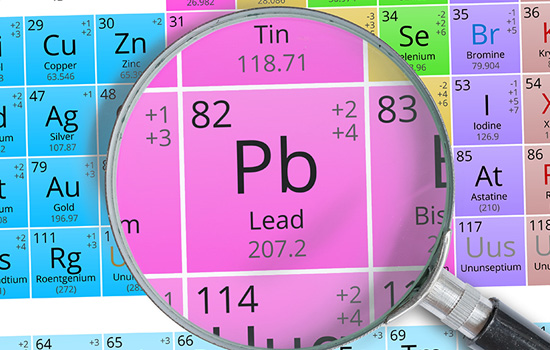
Where is lead found?
Although the U.S. Congress took steps to limit lead in pipes in 1986 and again in 2014, lead may still be in a home’s plumbing and fixtures. Lead in plumbing can contribute to lead in drinking water by slowly dissolving into the water it comes in contact with, or breaking off in tiny pieces as the water flows through in a process called corrosion.
There is no lead in the water that leaves the Aquarion treatment plant, or the large underground pipes it runs through to reach customers, called water mains. But, lead can enter your tap water through a service line, which is the line that brings water from the main to your house, and also from the pipes, plumbing and faucets inside your home.
Aquarion consistently complies with Federal and State water quality standards, including those for lead. In some systems, Aquarion also adjusts the water’s chemistry to prevent corrosion that may result in lead at the tap. Each year, we report to customers the levels of lead and many other potentially hazardous substances that may be in water systems.

Lead Service Line Inventory
Enter your address and use our interactive map to check the material of your service line.
View Map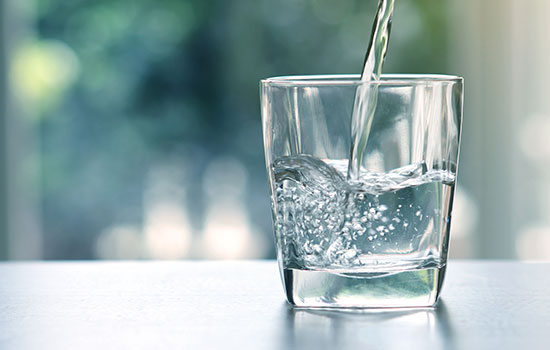
Minimize Your Exposure to Lead
Safeguard your home against lead with Aquarion's essential guide.
Learn More
Understanding your Aquarion service line letter
Aquarion is sending letters to customers about the materials of their water service lines as part of the U.S. Environmental Protection Agency’s (EPA) Lead and Copper Rule Revisions (LCRR), to promote transparency and safety. Receiving a letter DOES NOT mean there is lead in your drinking water. The letters aim to educate and gather information about your service line. Learn why you received a letter, what it means, and the next steps you can take.

Lead regulations
The U.S. Environmental Protection Agency’s Lead and Copper Rule (LCR) requires water systems test for lead and copper at the tap in certain homes. The tests focus on homes with lead service lines, which are expected to have higher lead concentrations.
Lead samples are required to be “first-draw samples,” or a sample taken from tap water that has stood motionless in the plumbing pipes for at least six hours. Water systems, like Aquarion, compare sample results from these homes to an action level (AL) of 0.015 milligrams per liter (mg/L), also known as 15 parts per billion. If 10 percent of the samples from these homes have lead above the 15 parts per billion (ppb) action level, then the systems must conduct public education, corrosion control treatment modification, and lead service line replacement if applicable.
Aquarion conducts many other water quality tests to comply with U.S. Environmental Protection Agency (EPA) regulatory requirements. To learn more about water quality in your area, read our Water Quality Reports.
Understanding the Lead and Copper Rule Revisions (LCRR)
As of October 2024, the EPA’s Lead and Copper Rule Revisions (LCRR) are in effect. Aquarion has taken steps to meet these requirements, which include:
- A public inventory of lead service lines (LSLs): Water systems must identify the locations of all known lead service lines. They must document the “lead status” of all other lines, such as unknown, not-lead, or galvanized service line. Customers can help Aquarion determine the material of their water service line by completing our Service Line Survey.
- Notification to customers with lead, unknown, or galvanized service lines: Water systems must provide educational resources to customers to help them minimize their exposure to lead. Aquarion customers can learn more by visiting our Minimize Your Exposure to Lead page.
Guide to identifying your service line material
Below, you’ll find a visual and descriptive guide to help you identify common pipe materials. From lead to plastic, learn the characteristics of each type and how to easily recognize them through simple tests and visual cues. Follow the steps below to learn how to identify your service line material:
- Find where the water comes into your building. This is usually in the basement!
- Observe the color of the pipe coming into your building.
- Perform a scratch test by gently scratching the pipe with a coin or a flathead screwdriver. Observe the scratch!
- Grab a magnet from your refrigerator and see if it sticks to the pipe.
- Now use the key below to match your characteristics.
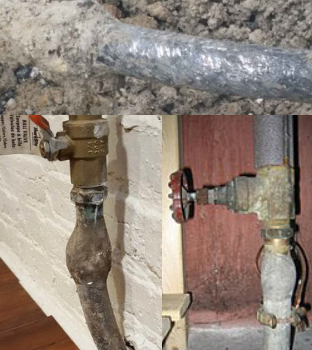
Lead
Lead pipes are gray or silver. Scratch test: shiny and silver (soft and scratches easily). Magnets will not stick. Widens at base and forms a "bulb."
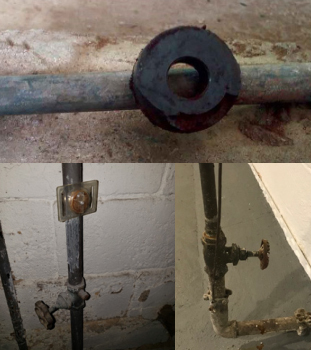
Galvanized Steel
Galvanized steel pipes are gray or silver. Scratch test: no visible scratch on surface. Magnets will stick. Has threads at connections.
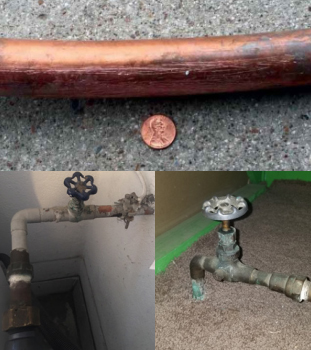
Copper
Copper pipes are dull brown; greenish. Scratch test: same color as penny. Magnets will not stick.
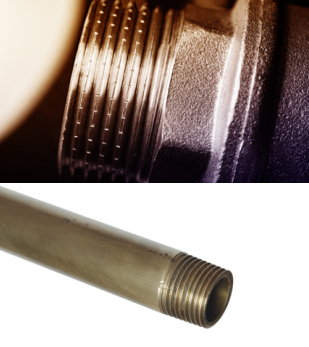
Brass
Brass pipes are brown, can have green corrosion spots. Scratch test: gold color. Magnets will not stick. Has threads at connections.
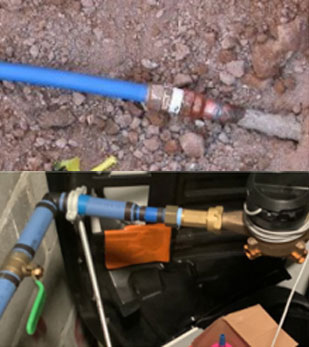
Plastic
Smooth and red, blue, black, or white.
Frequently Asked Questions (FAQ)
Lead is a naturally occurring metal harmful to humans if inhaled or swallowed. It can be in air, soil, dust, food, and water. Continued lead exposure means lead builds up in the body over many years, which can damage your brain, red blood cells, and kidneys.
Here are a few reasons why you should reduce your exposure to lead:
- If you eat, breathe, or swallow lead, it can sit in your body's organs for months.
- Your body cannot tell the difference between lead and calcium. So, if lead is not removed for your body, you store both substances in your bones. Lead can remain in your body throughout your lifetime.
- Lead is especially harmful to infants and children under age six. It can damage young, developing nervous systems. That damage can reduce a child's IQ, slow development and growth, cause learning disabilities and attention deficit disorders, and other unhealthy physical effects.
- Pregnant women should be extra careful, since lead will harm a developing fetus.
- In adults, lead can cause muscular, mental, and mood disorders, among other harmful conditions.
- Lead toxicity can be treated, but its bad effects cannot be cured, and the damage cannot be reversed.
Lead-based paint routinely used in homes and buildings built before 1978 is the most common source of exposure. Lead-based paint was banned in 1978.
Although water is not the main source of exposure, lead can be found in some water service lines and household plumbing. The EPA estimates that 10 to 20% of human exposure to lead may come from lead in drinking water. Infants who drink mostly mixed formula can receive 40 to 60% of their exposure to lead from drinking water.
The best way to ensure you are not at risk is to have your home tested for lead sources.
Talk to your healthcare provider about whether your child should be tested for lead. According to the Centers for Disease Control and Prevention:
“A blood test is the best way to determine if a child has been exposed to lead. If your child may have been exposed to lead, talk to your healthcare provider about getting a blood lead test. Based on your child’s blood lead test results, healthcare providers can recommend follow-up actions and care.”
Lead may be found in the following places in or outside of your home:
- Lead-based paint applied before it was banned in 1978
- Air from industrial emissions
- Soil contaminated by dust from past vehicle emissions and/or exterior lead paint
- Frequent contact with someone whose job or hobby involves exposure to lead
- Some imported foods, medicines, dishes, toys, and plastics
- Water that has passed through plumbing and fixtures that have lead
You can take many steps to reduce your exposure to lead in drinking water. Homeowners are responsible for the service lines on their property. So, if your plumber finds a lead service line, please take steps to replace it, and be sure to let us know so we can update our records and complete work of the remaining portion of the line.
Learn more about ways here: Minimize Your Exposure to Lead.
Lead is a very malleable metal. This made it a perfect material for plumbing until people discovered its toxic effects.
Despite the quality of our water sources and the overall effectiveness of our treatment process, households with service lines or plumbing systems with lead might still leach lead into their drinking water.
The chances of this occurring are highest in homes built before 1930, as they are more likely to have lead plumbing systems. Lead service lines, which can often be seen at their entry point through a home’s foundation, are dull grey and scratch easily to reveal a shiny surface.
You can take many steps to reduce your exposure to lead in drinking water. Homeowners are responsible for the service lines on their property. So, if your plumber finds a lead service line, please take steps to replace it, and be sure to let us know so we can update our records and complete work of the remaining portion of the line.
Learn more about ways here: Minimize Your Exposure to Lead (See Who Owns What). Aquarion will send out notices if we discover that your home has a lead service line. We strongly advise you have a licensed plumber replace it.
Houses built before 1986 are more likely to have lead-soldered plumbing joints. Lead solder used to join copper pipes is silver or grey. Hardware and home supply stores have kits that test the surface of soldered joints for lead. If you have lead-soldered joints, the chance of the lead leaching into your drinking water is greater when water has been standing in the pipes for many hours, such as overnight.
To check if your drinking water has lead and at what level, you can also have the water tested by a laboratory. A lab test is the only sure way of determining the lead level, since lead dissolved in water cannot be seen, tasted, or smelled.
For a list of testing laboratories, select your state:
- Connecticut Testing Laboratories
- Massachusetts Testing Laboratories
- New Hampshire Testing Laboratories
Contact laboratories directly for information on costs and sampling bottle requirement.
Lead is rarely—if ever—found naturally in Aquarion’s water sources or in the treated water flowing through our distribution system. More commonly, lead may leach into water over time through corrosion: the dissolving or wearing away of metal caused by a chemical reaction between water and some plumbing systems. Lead can leach into water from pipes, solder, fixtures, faucets (brass), and fittings. The amount of lead that may enter your water depends on the types and amounts of minerals in the water, how long the water stays in the pipes, how corrosive the water is, and the water’s temperature.
The most common plumbing components that may contribute to lead in your water are as follows:
Lead Service Lines
Despite the quality of our water sources and the effectiveness of our treatment process, lead can get into a home’s drinking water through lead service lines or through home plumbing systems that have lead. With a few exceptions, most lead service lines were installed in homes built before 1930. In 1986, lead pipes were banned in the United States and plumbing materials were required to meet federal “lead-free” specifications. There is a possibility that plumbers used leftover stock of lead supplies during work between 1986 and 1988. So, people in homes built before 1988 are at higher risk. If you are concerned about your home’s plumbing or service line, a certified plumber can inspect your service line, pipes, solder, and fittings for lead.
Lead service lines often can be seen where they enter the home's foundation. They are dull grey and if scratched (with a flathead screwdriver or coin) it will scratch easily and reveal a shiny surface.
Homeowners are responsible for the service lines on their property. So, if your plumber finds a lead service line, please take steps to replace it, and be sure to let us know so we can update our records and complete work of the remaining portion of the line.
Galvanized Pipe
Some older homes have service lines and/or plumbing systems made of galvanized iron piping.
- Galvanized pipes are made of iron or steel and coated with zinc as a layer of protection for the pipe.
- Over time, galvanized service lines can collect lead released from an upstream lead source (such as a service line or “gooseneck” connector to the main).
- The zinc coating on galvanized pipes may also have lead that can corrode and leach into the drinking water.
You can identify galvanized pipes by using a strong magnet, which will stick to the surface of the pipe. A scratch test with a screwdriver or nail will not disturb the surface as much and will remain dull gray. If your home has galvanized iron piping and was fed by a lead service line at any time (including currently), then you are at risk of lead being released into your water. We encourage you to have your water tested and your galvanized line replaced.
Aquarion regularly tests the water at a selected number of high-risk homes. If results exceed 15 parts per billion in more than 10% of “first-draw samples”* taken from household taps, we send notices to our customers in the affected systems. We provide instructions on what to do to limit lead exposure, as required by the EPA and your state agency.
While our sampling is a good screening technique, every home is different. Lead levels can vary from home to home depending on variables, like pipes, solder, and fixtures used. Since you cannot see, taste, or smell lead dissolved in water, testing is the best way to learn the lead level in your home. Certified testing laboratories can test your drinking water for lead. Contact labs directly for information on costs and sampling bottle requirements.
For a list of testing laboratories, select your state:
- Connecticut testing laboratories
- Massachusetts testing laboratories
- New Hampshire testing laboratories
*A “first-draw sample” is one taken from tap water that has stood motionless in the plumbing pipes for at least six hours.
No. Testing has shown that there is no lead in the water exiting our water treatment facilities. We even treat our water to reduce the chances of lead entering the supply from pipes and plumbing between our facilities and your taps.
Lead safety and prevention resources
State-specific lead information
- Connecticut Department of Public Health (CT DPH) Lead Free CT Program
- Massachusetts Department of Environmental Protection (MASSDEP) Lead Information
- New Hampshire Department of Environmental Services (NH DES) Lead FAQs
Federal guidelines and lead information
- Centers for Disease Control and Prevention (CDC) Lead Homepage
- Environmental Protection Agency (EPA) Basic Information about Lead in Drinking Water
- National Sanitation Foundation (NSF) – The Public Health and Safety Organization – List of Tested and Approved Filters for Lead
Lead safety in schools and childcare settings
Monitoring, Treatment & Distribution
Aquarion performs over 175,000 tests of its water annually.
Learn More